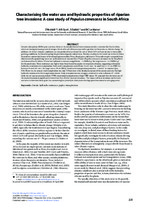| dc.contributor.author | Ntshidi, Z. | |
| dc.contributor.author | Gush, M.B. | |
| dc.contributor.author | Dzikiti, Sebinazi | |
| dc.contributor.author | Le Maitre, D.C. | |
| dc.date.accessioned | 2018-05-02T09:37:10Z | |
| dc.date.available | 2018-05-02T09:37:10Z | |
| dc.date.issued | 2018 | |
| dc.identifier.citation | Ntshidi, Z. et al. (2018). Characterising the water use and hydraulic properties of riparian tree invasions: A case study of Populus canescens in South Africa. Water SA, 44(2): 328 - 337 | en_US |
| dc.identifier.issn | 1816-7950 | |
| dc.identifier.uri | http://dx.doi.org/10.4314/wsa.v44i2.18 | |
| dc.identifier.uri | http://hdl.handle.net/10566/3626 | |
| dc.description.abstract | Invasive alien plants (IAPs) pose a serious threat to the already limited water resources in dry countries like South Africa
which are facing increasing water shortages. Much of South Africa is expected to get drier in future due to climate change. In
addition, the future climatic conditions are also predicted to accelerate the rate at which IAPs will spread, due to favourable
growing conditions, further disrupting the provision of goods and services. Previous studies on tree water use in South Africa
focused on commercial forests of introduced genera mainly Pinus, Eucalyptus, and Acacia. This study sought to expand these
observations by quantifying water use and its drivers in riparian Grey Poplar (Populus canescens) invasions in the Berg River
catchment of South Africa. Whole tree hydraulic resistance ranged from ~ 1.4 MPa·h·g-1 for large trees to ~14.3 MPa·h·g-1
for the small ones. These resistances are higher than those found for poplars in temperate climates, suggesting substantial
hydraulic constraints to transpiration. Daily peak transpiration varied from 5 to 6 L·tree-1 in small trees (~9.2 cm DBH) to
between 35 and 40 L·tree-1 for large trees (~24 cm DBH). Stand-level transpiration peaked at ~4 mm·d-1 in summer (Jan–
Feb). However, the annual total transpiration was only 338 mm due to the deciduous nature of the species and also the high
hydraulic resistance in the transpiration stream. Daily transpiration was strongly correlated to solar radiation (R2 > 0.81)
while the air vapour pressure deficit (VPD) constrained transpiration at high VPD values. We conclude that the water use of
the poplar invasions is significantly lower than that of other riparian invasions. The impact of these invasions on the water
resources is therefore likely quite low, warranting less priority in alien plant clearing operations aimed at salvaging water. | en_US |
| dc.language.iso | en | en_US |
| dc.publisher | Water Research Commission | en_US |
| dc.rights | Published under a Creative Commons Attribution Licence | |
| dc.subject | Climate | en_US |
| dc.subject | Hydraulic resistance | en_US |
| dc.subject | Poplar | en_US |
| dc.subject | Transpiration | en_US |
| dc.title | Characterising the water use and hydraulic properties of riparian tree invasions: A case study of Populus canescens in South Africa | en_US |
| dc.type | Article | en_US |
| dc.privacy.showsubmitter | FALSE | |
| dc.status.ispeerreviewed | TRUE | |

